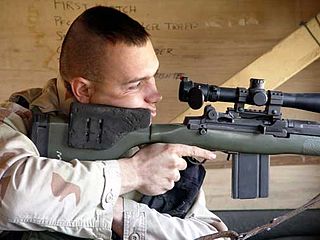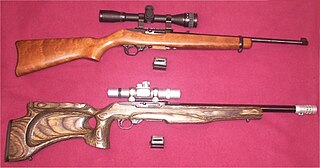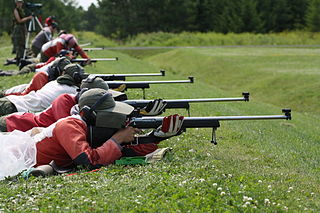
In firearm designs, the term single-shot refers to guns that can hold only a single round of ammunition inside and thus must be reloaded manually after every shot. Compared to multi-shot repeating firearms ("repeaters"), single-shot designs have no moving parts other than the trigger, hammer/firing pin or frizzen, and therefore do not need a sizable receiver behind the barrel to accommodate a moving action, making them far less complex and more robust than revolvers or magazine/belt-fed firearms, but also with much slower rates of fire.

Bolt-action is a type of manual firearm action that is operated by directly manipulating the bolt via a bolt handle, which is most commonly placed on the right-hand side of the firearm.

The Lee–Enfield is a bolt-action, magazine-fed repeating rifle that served as the main firearm of the military forces of the British Empire and Commonwealth during the first half of the 20th century, and was the standard service rifle of the British Armed Forces from its official adoption in 1895 until 1957.

Fabbrica d'Armi Pietro Beretta is a privately held Italian firearms manufacturing company operating in several countries. Its firearms are used worldwide for a variety of civilian, law enforcement, and military purposes. Sporting arms account for three-quarters of sales; Beretta is also known for marketing shooting clothes and accessories. Founded in the 16th century, Beretta is the oldest active manufacturer of firearm components in the world. Its inaugural product, in 1526, was the arquebus barrel; by all accounts Beretta-made barrels equipped the Venetian fleet at the Battle of Lepanto in 1571. Beretta has supplied weapons for every major European war since 1650.

A designated marksman (DM), squad advanced marksman (AD) or squad designated marksman (SDM) is a military marksman role in an infantry squad. The term sniper was used in Soviet doctrine although the soldiers using the Dragunov SVD were the first to use a specifically designed designated marksman rifle. The analogous role in the Israel Defense Forces is sharpshooter.

The Vektor R4 is a South African 5.56×45mm assault rifle. It entered service as the standard service rifle of the South African Defence Force (SADF) in 1980. In South African service, the R4 replaced the R1, a variant of the 7.62×51mm FN FAL. It was produced by Lyttelton Engineering Works, now Denel Land Systems.

The SEAL Recon Rifle is an American designated marksman rifle and assault rifle used by the United States Navy SEALs. Essentially a heavily modified M16 rifle, it is intended to provide SEAL snipers and designated marksmen with a versatile, accurate, lightweight, and relatively compact weapon chambered in 5.56×45mm NATO.

Accurizing is the process of improving the accuracy and precision of a gun.

Metallic silhouette shooting is a group of target shooting disciplines that involves shooting at steel targets representing game animals at varying distances, seeking to knock the metal target over. Metallic silhouette is shot with large bore rifles fired freehand without support out to 500 meters, and with large bore handguns from the prone position with only body support out to 200 meters. Competitions are also held with airguns and black-powder firearms. A related genre is shot with bow and arrow, the metal targets being replaced with cardboard or foam. The targets used are rams, turkeys, pigs, and chickens, which are cut to different scales and set at certain distances from the shooter depending on the specific discipline.

A designated marksman rifle (DMR) is a modern scoped high-precision rifle used by infantry in the designated marksman (DM) role. It generally fills the engagement range gap between a service rifle and a dedicated sniper rifle, at around 300–600 metres (330–660 yd).

Fullbore Target Rifle (TR) is a precision rifle shooting sport discipline governed by the International Confederation of Fullbore Rifle Associations (ICFRA). The sport evolved as a distinct British and Commonwealth of Nations discipline from Service rifle (SR) shooting in the late 1960s. Its development was heavily influenced by the British National Rifle Association (NRA). Due to this history, it is usually contested amongst the shooting events at the Commonwealth Games, although not at the Olympics. World Championships are held on a four-year cycle. The annual NRA Imperial Meeting at Bisley in the UK is globally recognised as a historic annual meeting for the discipline.

The Vektor SP1 was an improved 9mm version of the Z-88 pistol, produced since 1992 by Denel Land Systems (DLS), formerly Lyttelton Engineering Works (LIW).
Gallery rifle shooting or gallery rifle and pistol shooting is a popular shooting sport throughout the world. In countries such as the UK, Ireland, Germany, South Africa and Australia national and international competitions are regularly undertaken. The discipline commonly uses rifles shot at short and medium distances chambered for traditional pistol calibers such as .22 Long Rifle, .38 and .357 calibers, .44 and .45. It is popular in countries where traditional pistol shooting is difficult or not possible. In the UK Long Barreled Pistols (LBPs) and Long Barreled Revolvers (LBRs) are also part of the overall discipline.
Chiappa Firearms, Armi Sport di Chiappa, is an Italian firearms manufacturing company based in Brescia. It was founded in 1958 by Ezechiele Chiappa as Armi Sport. Total unit production is around 60,000 per year. Its U.S. headquarters are in Dayton, Ohio.

A varmint rifle is a small-caliber precision firearm or high-powered airgun primarily used for both varmint hunting and pest control. These tasks include killing three types of pests or nuisance animals that spread diseases or destroy crops or livestock:
The Swing rifle was a design developed by a number of target shooting enthusiasts who came together in 1970 at Bisley. The design's primary instigators were George Swenson and Laurie Ingram. At the time target rifle competition in the UK was dominated by designs based on military actions such as those of the Lee–Enfield and Mauser 1898. These designs were felt to have reached the limits of their development potential; especially when combined with commercially manufactured or hand-loaded ammunition.

The National Shooting Centre is the UK's largest shooting sports complex, comprising several shooting ranges as well as the large "Bisley Camp" complex of accommodation, clubhouses and support services. The centre is located near the village of Bisley in Surrey from which it takes its colloquial name "Bisley ranges". The site is wholly owned by the National Rifle Association (NRA). The NSC is the trading name of the facility.

A cadet rifle is a rifle used by military cadets and others for basic firearms and marksmanship training. Generally .22 caliber and bolt-action, they also come in semi-automatic versions. They are often miniature .22 caliber versions of standard issue service rifles.














